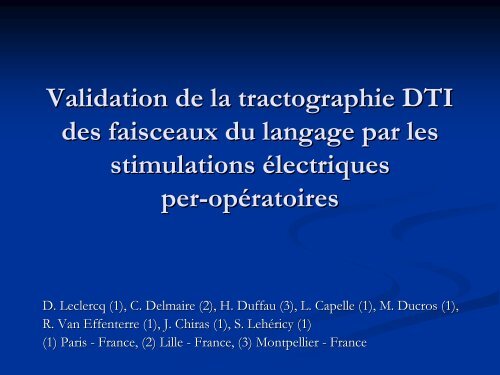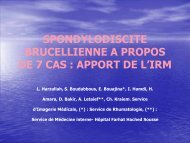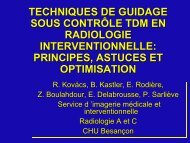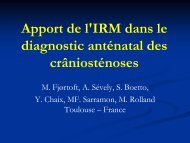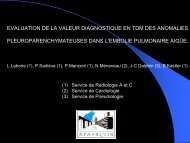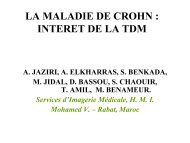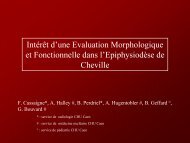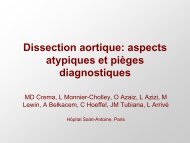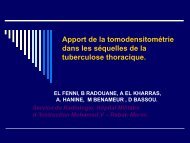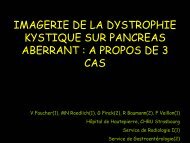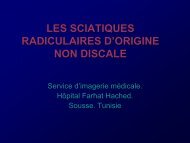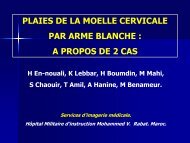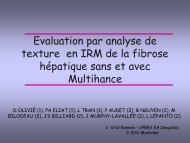Validation de la tractographie DTI des faisceaux du langage par les ...
Validation de la tractographie DTI des faisceaux du langage par les ...
Validation de la tractographie DTI des faisceaux du langage par les ...
Create successful ePaper yourself
Turn your PDF publications into a flip-book with our unique Google optimized e-Paper software.
<strong>Validation</strong> <strong>de</strong> <strong>la</strong> <strong>tractographie</strong> <strong>DTI</strong><br />
<strong>de</strong>s <strong>faisceaux</strong> <strong>du</strong> <strong>la</strong>ngage <strong>par</strong> <strong>les</strong><br />
stimu<strong>la</strong>tions électriques<br />
per-op<br />
opératoires<br />
D. Leclercq (1), C. Delmaire (2), H. Duffau (3), L. Capelle (1), M. Ducros (1),<br />
R. Van Effenterre (1), J. Chiras (1), S. Lehéricy<br />
(1)<br />
(1) Paris - France, (2) Lille - France, (3) Montpellier - France
Problématique<br />
Chirurgie <strong>de</strong>s gliomes <strong>de</strong> bas gra<strong>de</strong> :<br />
Seule une exérèse complète peut permettre une guérison complète.<br />
Résection incomplète : éten<strong>du</strong>e <strong>de</strong> l’exl<br />
exérèse = facteur pronostique.<br />
Objectif : exérèse <strong>la</strong> plus complète possible sans séquelle. s<br />
<br />
IRM fonctionnelle : exploration pré-chirurgicale <strong>du</strong> cortex<br />
Tractographie en tenseur <strong>de</strong> diffusion : étu<strong>de</strong> <strong>de</strong>s <strong>faisceaux</strong> <strong>de</strong><br />
substance b<strong>la</strong>nche mais peu validée.
Anatomie fonctionnelle <strong>du</strong> <strong>la</strong>ngage<br />
Prédominance :<br />
Droitiers : 96% hémisphh<br />
misphère gauche, 4% bi<strong>la</strong>téral<br />
Gauchers : 76% hémisphère gauche, 14% bi<strong>la</strong>téral, 10% hémisphh<br />
misphère droit<br />
<br />
<br />
<br />
Dispositif phonémique<br />
mique (reconnaît t <strong>les</strong> phonèmes et <strong>les</strong> syl<strong>la</strong>bes indépendamment<br />
<strong>de</strong> leur signification)<br />
mantique (traite le contenu <strong>du</strong> discours et le sens <strong>de</strong>s mots)<br />
Dispositif sémantique s<br />
Expression <strong>du</strong> <strong>la</strong>ngage
Faisceau arqué<br />
Segment antérieur<br />
frontal <strong>par</strong>iétal inférieur<br />
Segment médian m<br />
(segment long)<br />
frontal temporal<br />
Segment postérieur<br />
<strong>par</strong>iétal inférieur<br />
temporal<br />
Partie ventrale <strong>du</strong> faisceau dans <strong>la</strong> capsule externe.
Faisceau arqué<br />
Aires fronta<strong>les</strong>, <strong>par</strong>iéta<strong>les</strong>, occipita<strong>les</strong> et tempora<strong>les</strong><br />
dont Broca et Wernicke.<br />
Stimu<strong>la</strong>tions sous-cortica<strong>les</strong> : aphasie <strong>de</strong> con<strong>du</strong>ction.<br />
(Trouble <strong>de</strong> <strong>la</strong> répétition, r<br />
sans trouble articu<strong>la</strong>toire ni trouble majeur <strong>de</strong> <strong>la</strong> compréhension)
Faisceau occipito-frontal inférieur<br />
Cortex frontal<br />
inféro<br />
ro-<strong>la</strong>téral et<br />
dorso<strong>la</strong>téral<br />
ral<br />
Capsule externe<br />
Cortex temporal postérieur<br />
et occipital<br />
Rôle sémantique s<br />
: stimu<strong>la</strong>tions = <strong>par</strong>aphasies sémantiques. s
Faisceau subcallosal medialis<br />
Cingulum<br />
Aire motrice<br />
supplémentaire<br />
Tête caudé<br />
Aphasie transcorticale motrice, initiation <strong>du</strong> <strong>la</strong>ngage
Voie finale commune<br />
Cortex<br />
prémoteur ventral<br />
Aire motrice<br />
supplémentaire<br />
Pédoncule cérébralc<br />
Stimu<strong>la</strong>tions : anarthrie
MATERIEL ET METHODE<br />
10 patients opérés éveillés s avec stimu<strong>la</strong>tions per-op<br />
opératoires pour<br />
<strong>de</strong>s tumeurs cérébra<strong>les</strong> c<br />
en zone <strong>de</strong> <strong>la</strong>ngage.<br />
Protocole :<br />
-Pré-opératoire<br />
: - acquisition tridimensionnelle T1<br />
- Tenseur <strong>de</strong> diffusion 6 directions.<br />
-Post-opératoire<br />
: acquisition tridimensionnelle T1<br />
6 semaines - 6 mois après s l’intervention.<br />
l
MATERIEL ET METHODE<br />
Tractographie :<br />
Entre ntre 2 régions r<br />
d’intd<br />
intérêt<br />
(ROIs) cortico-sous<br />
sous-cortica<strong>les</strong>.<br />
Intérêt<br />
: Modification <strong>de</strong> l’anatomie l<br />
<strong>par</strong> l’effet l<br />
<strong>de</strong> masse.<br />
Le faisceau reconstruit pourrait alors comporter <strong>de</strong>s fibres<br />
ap<strong>par</strong>tenant à d’autres <strong>faisceaux</strong> adjacents.<br />
Métho<strong>de</strong><br />
tho<strong>de</strong> : - ROI corticale : toutes aires cortica<strong>les</strong> <strong>du</strong> faisceau<br />
- ROI profon<strong>de</strong> sur le trajet anatomique <strong>du</strong> faisceau<br />
Repères anatomiques i<strong>de</strong>ntiques pour chaque patient.
MATERIEL ET METHODE<br />
Reca<strong>la</strong>ge sur l’imagerie l<br />
post-op<br />
opératoire<br />
Confrontation avec <strong>les</strong> stimu<strong>la</strong>tions per-op<br />
opératoires :<br />
Cavité opératoire<br />
- <strong>faisceaux</strong> / photographies per-op<br />
- CRO<br />
Anarthrie
RESULTATS<br />
<br />
95% <strong>de</strong>s <strong>faisceaux</strong> reconstruits<br />
81% corré<strong>la</strong>tion entre <strong>faisceaux</strong> et stimu<strong>la</strong>tions<br />
<br />
<br />
Pas <strong>de</strong> « faux positifs » : tous <strong>faisceaux</strong> testés s => trouble <strong>du</strong> <strong>la</strong>ngage<br />
lors <strong>de</strong>s stimu<strong>la</strong>tions<br />
Troub<strong>les</strong> <strong>du</strong> <strong>la</strong>ngage in<strong>du</strong>its / faisceau cohérents littérature
LIMITES<br />
<br />
<br />
Reca<strong>la</strong>ge <strong>de</strong>s images tenseur <strong>de</strong> diffusion / anatomie post-op<br />
opératoire<br />
(modification anatomie)<br />
Fibres operculo-insu<strong>la</strong>ires<br />
= non reconstruites (anatomie non décrite) d<br />
troub<strong>les</strong> articu<strong>la</strong>toires en per-op<br />
opératoire<br />
modifications <strong>de</strong> l’anisotropie l<br />
++<br />
=> faisceau non reconstruit/interrompu<br />
Fibres issues cortex prémoteur ventral<br />
Tumeur<br />
Fibres non reconstruites
Modification <strong>de</strong> l’anisotropiel<br />
Faisceau interrompu<br />
Faisceau<br />
non reconstruit<br />
Stimu<strong>la</strong>tion positive<br />
Interruption faisceau arqué<br />
Modification orientation<br />
vecteurs en péri-tumoral
Faible anisotropie:<br />
- modifier <strong>par</strong>amètres <strong>de</strong> reconstruction:<br />
FA minimale et angle maximal<br />
- reconstruction <strong>du</strong> faisceau contro<strong>la</strong>téral ral utile<br />
(faisceau interrompu?)<br />
- vérification orientation vecteurs principaux en périphp<br />
riphérie rie tumeur.<br />
Reca<strong>la</strong>ge:<br />
Parfois plusieurs reca<strong>la</strong>ges pour un même patient en fonction<br />
<strong>de</strong> l’él<br />
’étage<br />
étudié.
CONCLUSION<br />
Technique prometteuse pour l’exploration l<br />
<strong>de</strong>s <strong>faisceaux</strong> <strong>du</strong><br />
<strong>la</strong>ngage en pré-chirurgical<br />
Limites liées aux modifications d’anisotropie<br />
d<br />
Parfois fibres fonctionnel<strong>les</strong> dans zone d’anisotropie<br />
d<br />
presque nulle<br />
Outil très s prometteur pour l’él<br />
’étu<strong>de</strong> <strong>du</strong> <strong>la</strong>ngage en sous-<br />
cortical


